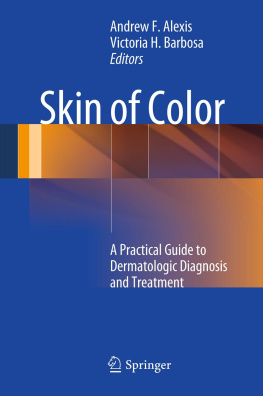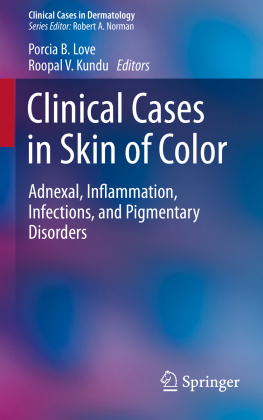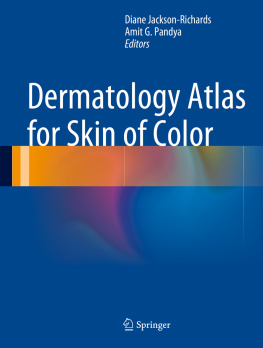Andrew F. Alexis and Victoria H. Barbosa (eds.) Skin of Color 2013 A Practical Guide to Dermatologic Diagnosis and Treatment 10.1007/978-0-387-84929-4_1 Springer Science+Business Media New York 2013
1. Structural, Physiological, Functional, and Cultural Differences in Skin of Color
Adedamola Adegbenro 1 and Susan Taylor 2
(1)
Department of Dermatology, Riverside Family Medicine Residency, Newport News, VA, USA
(2)
Society Hill Dermatology and Columbia University College of Physicians and Surgeons, Philadelphia, PA, USA
Abstract
Skin of color is defined as non-Caucasian skin types, which by Fitzpatricks classification comprise skin types III-VI. There is great variability in skin pigmentation among distinct racial and ethnic groups, making it difficult to define skin types simply by ethnicity, race, or culture. Individuals with darker skin comprise a wide range of racial and ethnic groups including Africans, African-Americans, African-Caribbean, Japanese, Chinese, Asians, Latinos, Indians, and Pakistanis, to name just a few. Presently, individuals with pigmented skin comprise 80% of the world population. As expected, demand for health care services by individuals with skin of color will grow substantially as this population grows. This demand will also expand as newer technologies and treatment for skin diseases develop. Therefore, the importance of studying the differences that exist in the structure, physiology, function, and culture of ethnic skin cannot be overemphasized. Most of the early literature on pigmented skin has produced conflicting results that are difficult to interpret or generalize. This is as a result of small sample sizes, non-standardized approaches and methodologies, varying anatomic sites, and the use of subjective parameters. This chapter will summarize the current data regarding ethnic skin differences. An understanding of structural, physiological, and functional differences in pigmented skin will lead to a better grasp of the pathophysiologic mechanisms of skin diseases particularly those that disproportionately affect the ethnic population.
Skin of color is defined as non-Caucasian skin types, which by Fitzpatricks classification comprise skin types III-VI. There is great variability in skin pigmentation among distinct racial and ethnic groups, making it difficult to define skin types simply by ethnicity, race, or culture. Individuals with darker skin comprise a wide range of racial and ethnic groups including Africans, African-Americans, African-Caribbean, Japanese, Chinese, Asians, Latinos, Indians, and Pakistanis, to name just a few (Table ].
Table 1.1
Groups that comprise persons defined as having ethnic skina
Black | African, people of African descent, including African American, Caribbean-American, and Latin-American persons |
Latino or Hispanic | Persons of Spanish and indigenous Central/South American descent, including Central Americans, South Americans, and Caribbean-American; persons of Spanish descent, including Cuban, Puerto Rican, and Dominican |
East Asian | Chinese, Japanese, Korean |
Southeast Asian and Pacific islander | Filipino, Vietnamese, Cambodian, Thai, Malaysian, Laotian, Burmese, Hmong descent, Polynesian, Micronesian |
Australoid | Australian aborigine, Melanesian descent (the Republic of Guinea, Papua, Solomon Islands) |
Native Americans | More than 560 recognized tribes, including Inuit (Native Alaskans) |
South Asia | Indian, Pakistani, Bangladesh, Sri Lanka |
Middle Eastern | Iranian, Iraqi, persons from Saudi Arabia and the Arabian Peninsula (including Kuwait, Bahrain, Oman, Qatar, the United Arab Emirates, Yemen), Lebanese, Afghani, Jordanian, Syrian, Israeli , Turkish, North African (Egypt, Morocco, Algeria, Libya) |
From Talakoub and Wesley [], with permission of Elsevier
aTraditionally, there are nine geographic races, each with particular genetic similarities. These geographic races include Europeans (which include Middle Eastern and Mediterranean persons), Eastern Indians, Asians, American Indians, Africans, Melanesians, Micronesians, Polynesians, and Australian aborigines. We modify these schema into categories in which ethnic persons share similar anatomic characteristics
The US census indicates that by the year 2056, greater than 50% of the US population will be non-Caucasian []. As expected, demand for health care services by individuals with skin of color will grow substantially as this population grows. This demand will also expand as newer technologies and treatment for skin diseases develop. Therefore, the importance of studying the differences that exist in the structure, physiology, function, and culture of ethnic skin cannot be overemphasized.
Most of the early literature on pigmented skin has produced conflicting results that are difficult to interpret or generalize. This is as a result of small sample sizes, non-standardized approaches and methodologies, varying anatomic sites, and the use of subjective parameters. This chapter will summarize the current data regarding ethnic skin differences. An understanding of structural, physiological, and functional differences in pigmented skin will lead to a better grasp of the pathophysiologic mechanisms of skin diseases particularly those that disproportionately affect the ethnic population.
Basic Structure and Function of Skin
Stratum Corneum
The stratum corneum deserves special mention given that, as the outermost layer of the skin, it is the skins primary protective barrier from the environment. It is also the layer of the skin that has received the most attention in studies on differences between skin types. The stratum corneum is a two-compartment system comprised of disk-like corneocytes embedded in a matrix of lipid-enriched membranes. Individual corneocytes contain keratin filaments and osmotically active molecules such as filaggrin encased in a resistant, flexible cell envelope. Within the intercellular spaces of the corneocytes are lipids which provide the permeability barrier of the skin. The lipids include ceramides, cholesterol, long-chain saturated fatty acids, and other less active constituents. These lipids are elaborately organized into multilamellar structures. The stratum corneum functions primarily to prevent water loss from the interior cell layers of the skin. It serves as the interface barrier between the body and the external environment. Consequently, it protects against mechanical insult, irritant/foreign chemicals, ultraviolet light, and microorganisms.
Epidermis
The other layers of the epidermis are highly cellular and composed mainly of keratinocytes. These layers are divided into the basal layer, stratum spinosum, and stratum granulosum based on the morphology of the cells comprising each layer. The basal layer, which is the innermost layer of the epidermis, contains an actively dividing population of keratinocytes. An important constituent of the basal layer of the epidermis is melanocytes, which are derived from neural crest cells and are responsible for the production of melanin pigment. Melanocytes produce melanin which is packaged into organelles termed melanosomes. The melanosomes are subsequently transferred to adjacent keratinocytes via phagocytosis. It is thought that melanin absorbs radiant energy from the sun and protects the skin from the harmful effects of ultraviolet radiation. The ratios of melanocytes to keratinocytes in the epidermis vary by anatomic sites as a function of the degree of sun exposure.













